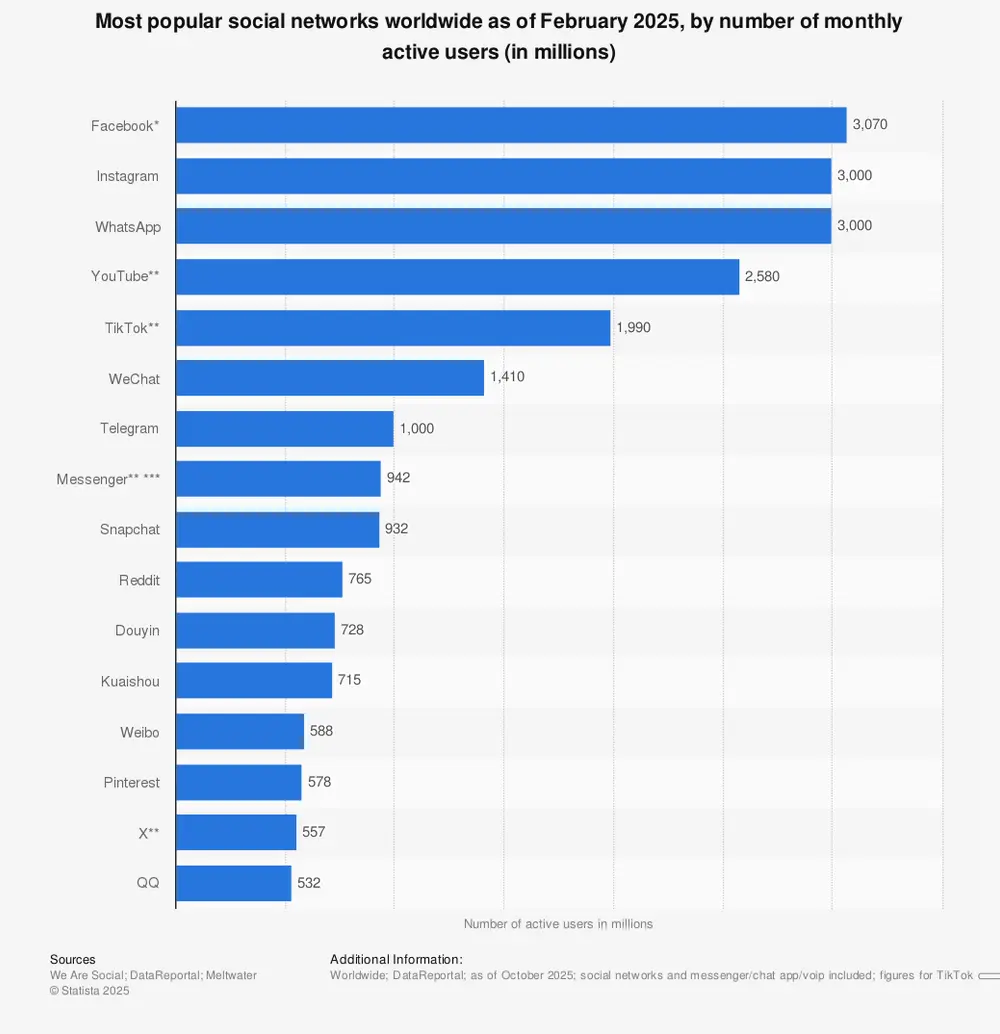Having a social media budget is no longer enough to create an impact online and engage customers. Apart from keeping tabs on social media trends, the type of social media platform you choose plays a major role in digital marketing success. Comparing social media platforms empowers you to determine the one that best suits your business and objectives.
Text-based networks like Facebook and X excel in increasing website traffic. Instagram and Pinterest are better at building brand awareness through visual storytelling.
This article explores the top eight social media platforms and their benefits and limitations so you can determine which to include in your marketing strategy.
Comparing the 8 Best Social Media Platforms in 2024:
8 Best Social Platforms to Consider in 2024
Social media has become a global meeting room where people all over the world can connect. While it can be tempting to join as many channels as possible, managing multiple platforms can be challenging. About 52% of brands are concerned about investments in maintaining a presence on multiple social platforms.

Source: hootsuite.com
A little over 80% of marketers use more than three channels. To avoid spreading yourself too thin in managing more followers and communities than you can handle, this article can help you select the social channel that can best promote your brand.
1. Facebook
Facebook continues to be the most widely used social media network among marketers. The platform also shares the No. 1 spot with Instagram as the highest ROI platform.
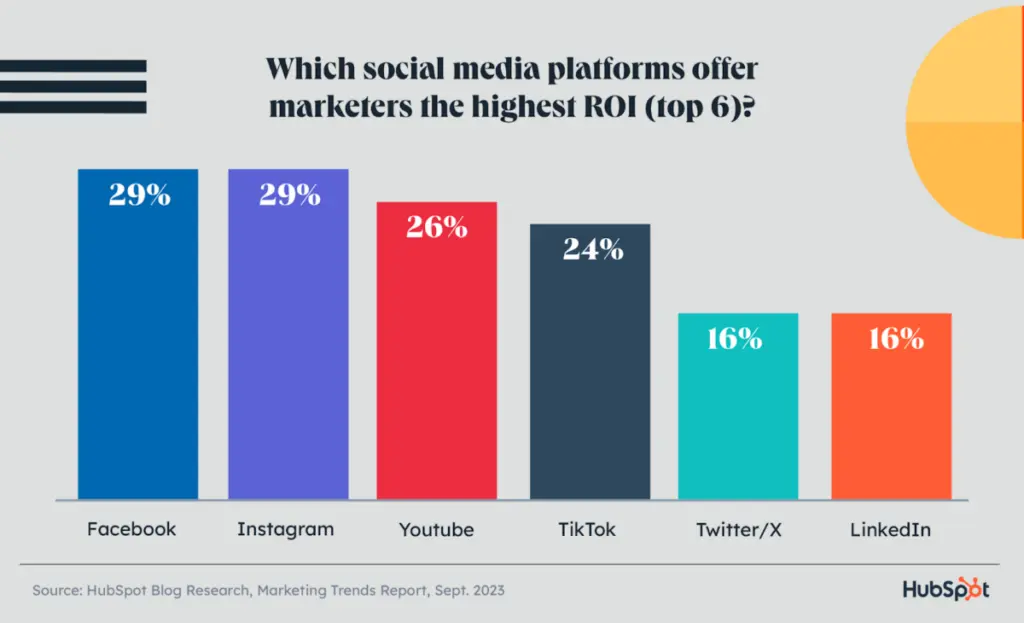
Source: blog.hubspot.com
Around half of Facebook users visit company websites featured in posts or Facebook Stories to get more information or place an order. Moreover, 30% of US-based adults rely on Facebook for news.
Pros:
- Audience: Facebook has an over 3-billion-strong audience worldwide. It's also the most preferred channel for B2B (67%) and B2C (58%) marketing.
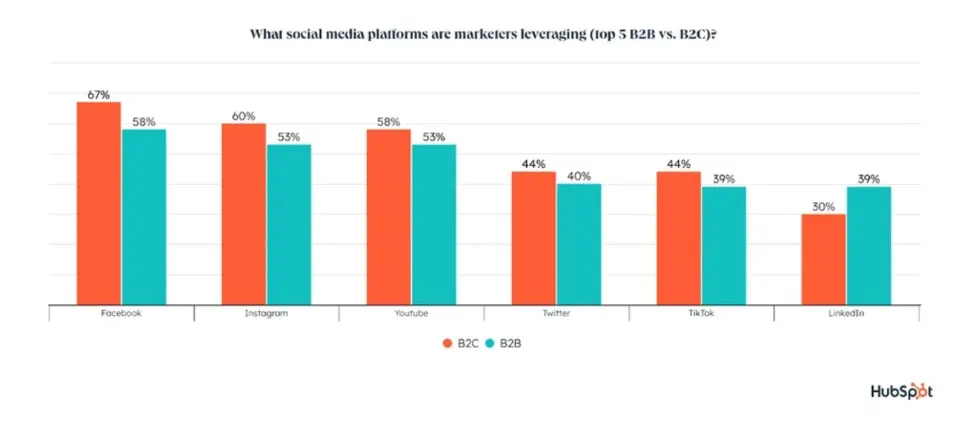
Source: blog.hubspot.com
In the US, Facebook has a diverse audience, with all age groups almost equally represented: 18-29 (20%), 30-39 (29%), 40-49 (22%) and 50-64% (29%).

Source: statista.com
- Facebook Insights: This analytics feature shows your page's performance trends, which can guide engagement efforts and marketing campaign development.
- Ads: Facebook Ads are highly customizable, with targeting options for your audience's demographics, interests, and behavior patterns. Moreover, you can personalize the text, image, and timing of the ad's appearance in user feeds.
- Engagement: Facebook offers plenty of tools for interacting with your followers in real-time, like Messenger, Facebook Groups, and Facebook Live.
Cons:
- Changing algorithm: Facebook has changed its algorithm, with posts from a person's family and friends taking precedence over organic business posts. This development forces brands to spend on ads to increase their visibility.
- Content: You must strategically choose the content format for your posts, especially among younger audiences.
2. Instagram
Due to its visual focus, Instagram leads other social media for influencer marketing. The platform also offers the best tools for in-app shopping, resulting in the highest ROI for businesses in social selling.

Source: insiderintelligence.com
After static photos made a comeback on the platform last year, digital marketing pros foresee a mix of still images and photos filling Instagram accounts in 2024. At the start of 2023, Instagram chief Adam Mosseri said the company wanted to restore balance between the two content types. But by mid-2023, short videos still emerged as the winner, with 75% of engagement coming from Instagram Reels.
Pros:
- Formats: Account holders can choose from various formats—feed posts, stories, reels, and live—to tell their stories.
- eCommerce features: Brands can sponsor a creator's image or video, which would then become a shoppable post where an influencer's followers can make a direct purchase. Instagram Shop is also the most preferred social selling feature among marketers.
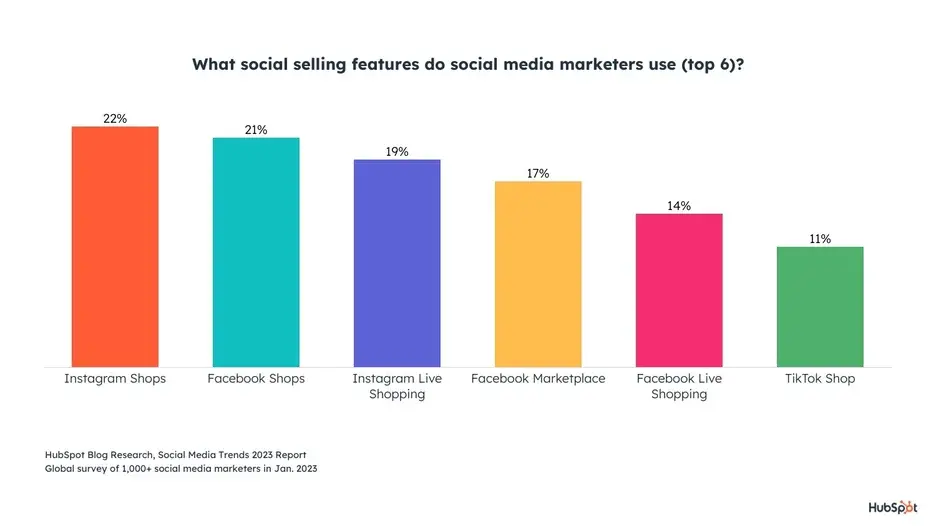
Source: blog.hubspot.com
- Ads: Switching to a professional or business account will give you access to different ad options.
- Appeals to younger audiences: Social users aged 25 to 34 (almost 47%) and 18 to 24 (33%) make up a majority of Instagrammers.
Cons:
- Not all links are clickable: Only the links you share on your bio, Instagram Threads, and Instagram Direct Messages are clickable. To view links on captions and comments on grid posts, users must copy-paste them on a web browser.
- Content production can be resource-intensive: Although user-generated content makes Instagram alive and relatable, you may have to invest more time and money to produce and regularly post images and videos with a compelling narrative.
- Poor visibility of organic content: Frequent posting and consistent engagement with your community aren't enough. You need a budget for ads to increase your discoverability on the platform.
3. YouTube
YouTube is the second most-visited website worldwide next to Google. Although the majority of users are from 25 to 34 years old, YouTube emerged as the most popular platform among US teens (aged 13 to 17) polled by the Pew Research Center, ahead of TikTok, Snapchat, and Instagram.
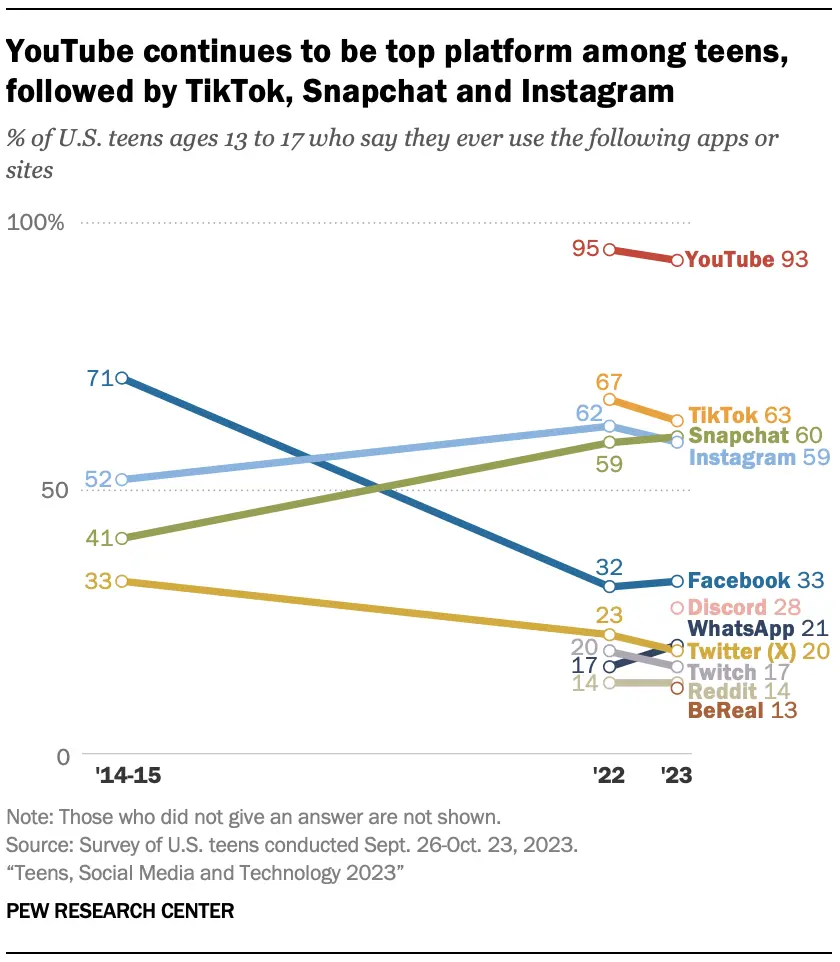
Source: pewresearch.org
YouTube has also become the fourth most favored affiliate marketing channel. In the US, 74% of users access the platform on mobile devices, surpassing TikTok's almost 38%.
Pros:
- YouTube Shorts: You can harness this minute-long format, which experts say brands will leverage this year as its monthly viewership skyrocketed to 2 billion in 2023. Moreover, this vertical format has delivered 10-20% more conversions per dollar than the horizontal format when used in ad campaigns.
- Revenue opportunities: Subscriptions (YouTube Partner Program) and affiliate marketing are among the ways you can monetize your YouTube channel.
- Brand authority: Produce and post tutorials, demos, and vlogs to establish your credibility and showcase expertise in your niche.
- SEO benefits: YouTube is a Google product so you can apply SEO on titles, tags, and descriptions to make your content rank higher.
- Rich analytics: YouTube's analytics dashboard offers plenty of insights on your content's performance so you can tweak your campaign strategy.
Cons:
- Ad blockers: Non-premium users can install software to bypass ads.
- Labor-intensive: Users upload about 2,500 new videos onto the platform every minute. With a saturated market and competition from AI-generated videos, brands must exert effort in professional-quality production and editing.
4. TikTok
Of all the forms of social media marketing, TikTok marketing will see the highest budget increase in 2024. After all, 61% of TikTokers buy from brands advertising on the channel.
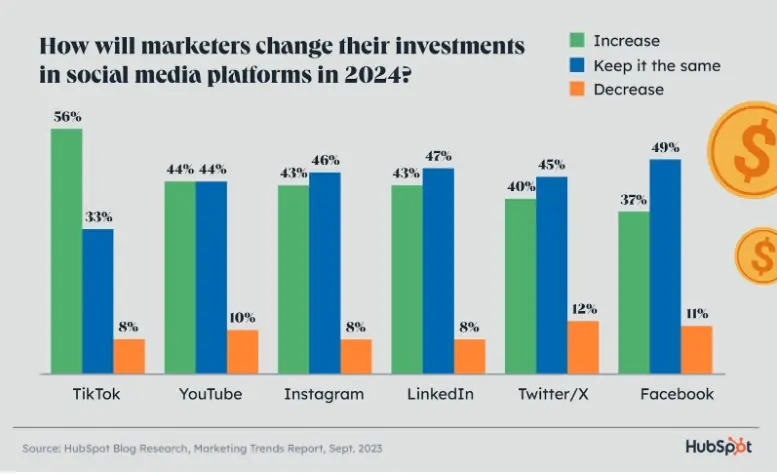
Source: blog.hubspot.com
According to the latest TikTok stats, Gen Z makes up the majority of its user base. Their preferences include watching Stories and short videos, and direct messaging.

Source: insiderintelligence.com
TikTok remained one of the most downloaded apps in 2023, with 272 million installs recorded in the third quarter of 2023.
Pros:
- Creation tools: TikTokers can create engaging videos with its unique features, such as Stitch, Duet, Sounds, and more.
- TikTok Stories: The users who liked and wrote comments on TikTok Stories are readily visible, unlike in Instagram Stories where you can only view the number of comments.
- TikTok Creator Marketplace: This online community offers numerous innovative content and collaboration opportunities.
- Shopify integration: Brands can sell products on the app by setting up a TikTok business account and syncing it with Shopify, allowing users to order products directly.
- Trackable ad performance: TikTok Ad Manager's analytics measures impressions, click rates, conversion rates, and audience demographics, enabling you to evaluate your campaign results and improve your future projects.
Cons:
- High advertising cost: TikTok's minimum daily budgets are over $50 for campaigns and $20 for ad groups.
- Static images can only be incorporated in videos: TikTok is a video-based, mobile-first platform. You can only upload photos as part of a slideshow or video.
5. Snapchat
Snapchat is another platform popular among younger audiences. About 57% of businesses advertise on Snapchat. Its engaging filters and time-bound messaging features can attract your most engaged followers.
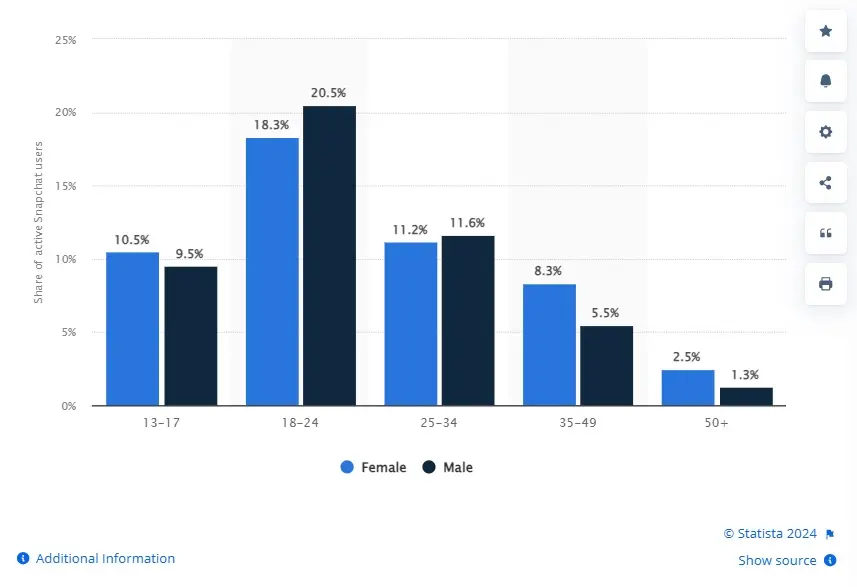
Source: statista.com
Users love using Snapchat to share behind-the-scenes content and sneak peeks of new products, giving it a sense of intimacy and exclusivity.
Pros:
- Customizable filters and lenses: Use Snapchat's templates or design your own using Lens Studio or Lens Web Builder. Let shoppers virtually try on your products with augmented reality tools using Camera Kit. Moreover, signing up for a business account allows you to create custom filters with age-targeting and dynamic text to highlight each of your store’s physical locations.
- Disappearing messages: You can set a timeframe for other Snapchatters to view your post to create a sense of urgency and FOMO.
- Shoppable Snap ads: Create and edit ads that link users directly to your site using Snap Publisher and track their performance on Snapchat Ads Manager.
- Emojis: You can add emojis to your posts as part of your branding and follower segmentation. Tools like Influencer Marketing Hub’s emoji generator are available for customization.
- Insights: Its analytics metrics include users’ average viewing time, interests, camera playtime, completion rate (for viewing Stories), and more.
- Creator partnerships: Find brand ambassadors with Snapchat’s Discover, Creator Marketplace, and Creator Collab Campaigns.
Cons:
- Not ideal for older shoppers and formal businesses: Snapchat's fun and quirky nature may be less appealing to more mature audiences. Snaps may not be suitable for industries that use more polished storytelling for marketing.
- Intense competition with Instagram and TikTok: Snapchat's top two rivals have more active monthly users and tools for permanently showcasing content.
6. X (formerly Twitter)
Amid video content dominance, X remains the preferred text-based platform for establishing authority in one's niche or industry. You can gain visibility and engagement on X by posting breaking news, trends, relevant hashtags, and timely responses to user tweets and followers' comments.
After rebranding to X, 63% of social media users told HubSpot they spend an hour or more on the app, three times more than its closest rival, Meta’s Threads. Moreover, 34% of users plan to use X in 2024 at the same rate as they did in 2023. Moreover, marketers are more optimistic about working with X (68%) than with Threads (32%).
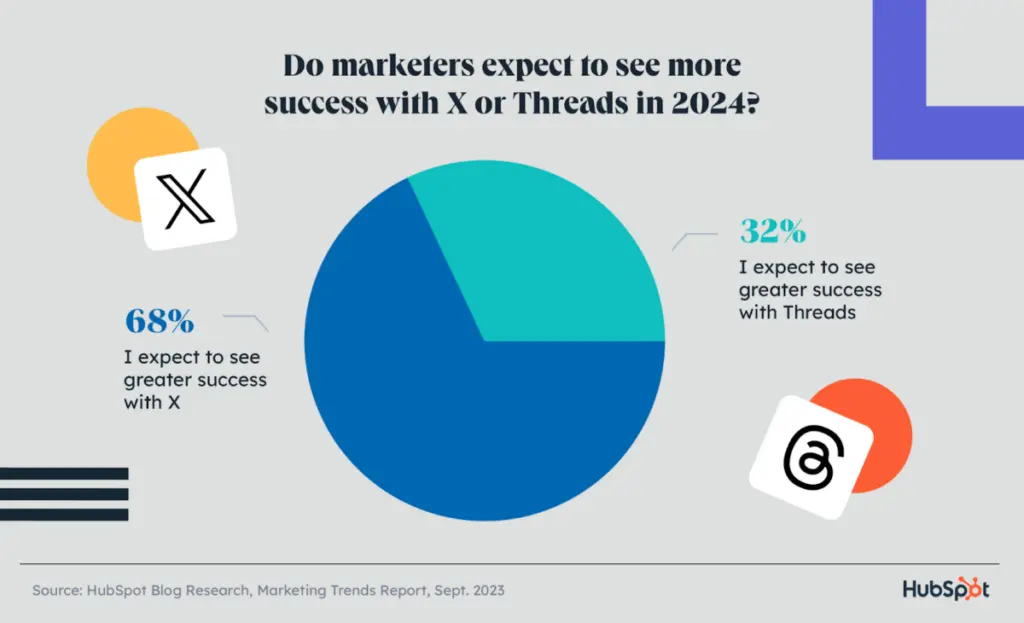
Source: blog.hubspot.com
Pros:
- Brevity/microblogging: X has been dubbed as a microblogging site, accommodating only 280 characters per post for non-premium subscribers. In 2023, the character limit for US-based premium users rose to 10,000 words. However, regular users can create a post thread to discuss a lengthy subject.
- Direct communications: Originally launched as an SMS text-based service, X encourages concise communication. You can address customer service concerns and network with industry partners and thought leaders.
- Live streaming: X launched a live stream function in 2023, with monetization options designed to compete with Twitch.
- Advertising: When you sign up for an X Ads account, you can target audiences based on demographics, topics, your current followers, and location. Your ads can be either text only or visuals (images, videos, or live).
Cons:
- Timing is crucial, especially for evergreen content: 42% of businesses send messages on the platform up to five times daily. Your Tweet can get buried by other posts as the hours pass by. You must study your analytics, apply SEO, and use a scheduling tool to automate the uploading of your evergreen content.
- Negative feedback can go viral quickly: Complaints against you or your company can easily spread in X’s fast-paced environment. Tact and timeliness are necessary for protecting your online reputation.
7. Pinterest
Pinterest has long served as an inspiration source for hobbyists, culinary enthusiasts, DIY home improvement fans, and fashionistas. It also has high-intent users, with 9 in 10 Pinners visiting the platform to plan their purchases. If you run an eCommerce business, you can create Pins to help drive traffic to your online store. Moreover, Pinterest has seen an increase in video uploads, with such content twice as likely to be shared than photos or still graphics.
Pros:
- Longevity of posts: When pins are optimized for SEO—with relevant keywords incorporated into your title, description, and hashtags—they can stay relevant for three months or more.
- Product search: You can use Pinterest's search function for trend spotting and market/competitor research.
- Merchant and affiliate programs: You can connect your store catalog and add shoppable links to your pins when you apply to be a verified Pinterest merchant. Also, you can find pinners in your niche to join your marketing efforts through affiliate links.
- Analytics: Pinterest shows real-time metrics of how other pinners have engaged with your pins and boards in the past 30 days.
- Augmented reality-supported pins: Business account holders with a product catalog can use this virtual try-on feature when selling or advertising their products.
- Cost-effective ads: The average cost per conversion/action is $0-$2, lower than Facebook and Instagram. Its average cost per click and cost per mille (CPM) is one of the lowest when comparing social media platforms’ CPM rates.

Source: adroll.com
- Pinterest Creator Fund Program: US-based Pinners from underrepresented sectors with 750 to 10,000 followers can apply for education resources and financial support.
Cons:
- Not for businesses without a visual component: Pinterest may not be profitable for businesses that don't sell products or have a visual component.
- Smaller audience: Recent Statista figures show that the platform ranks last among other social channels based on the number of monthly users.
8. LinkedIn
LinkedIn is the primary social channel used by 80% of B2B marketers. Users go to the site to stay updated with industry news and trends, engage with other professionals in their niche, and enhance their careers or business partnerships.

Source: insiderintelligence.com
Pros:
- Networking opportunities: 4 out of 5 of the platform’s members drive business decisions. Joining LinkedIn Groups related to your business can help you find clients, investors, partners, mentors, and influencers. Other engagement options include LinkedIn InMail, LinkedIn Live, and LinkedIn Polls.
- Targeted advertising: Businesses see a 33% growth in purchase intent and a doubling to tripling of brand attributes through LinkedIn ads.
- Content marketing: Using LinkedIn for content marketing can help showcase your thought leadership and industry experience. You can share professional milestones, new partnerships, and insights on industry developments. You can also combine articles with videos to make an impact as 59% of companies found LinkedIn an effective platform for sharing their business videos.
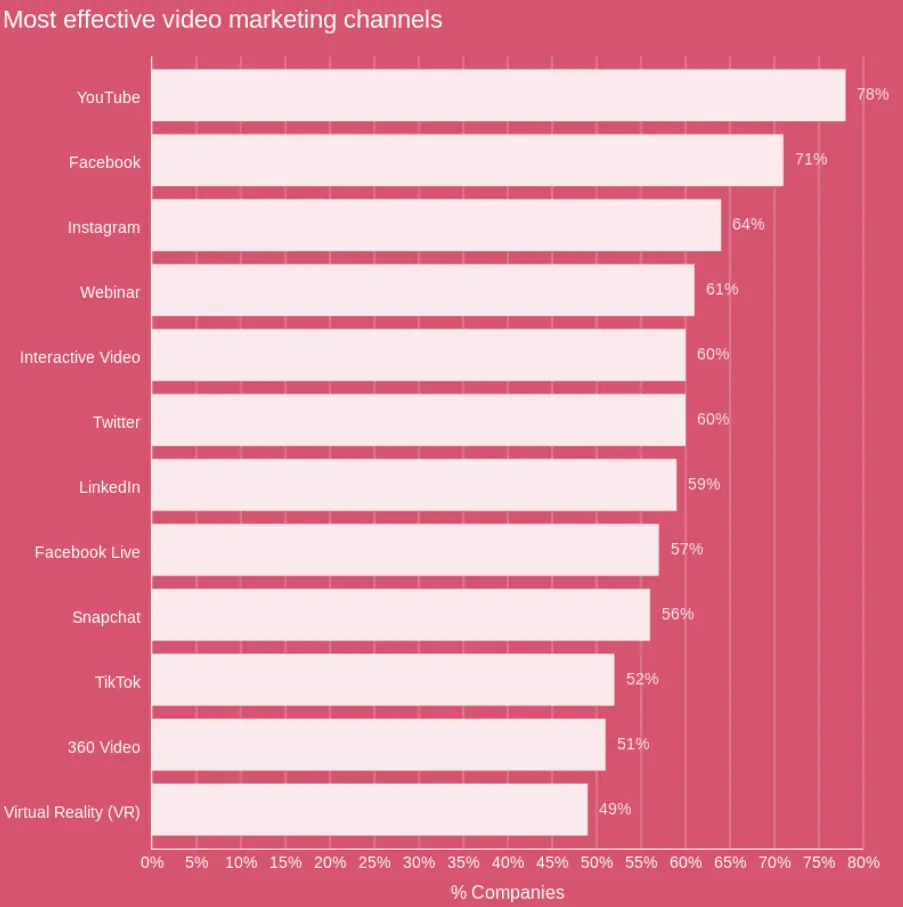
Source: wyzowl.com
- Profile and advanced analytics: LinkedIn shows your profile views, search appearances, new followers, new leads, competitors, and employee advocacy on its analytics page.
Cons:
- Expensive ads: Cost-per-click (CPC) ads can range from $2 to $10, much more expensive compared to Facebook and Instagram. Moreover, you need a premium account to access additional features, such as advanced search filters, InMail, and company and applicant insights.
- Low click-through rate: LinkedIn ads have an average CTR of 0.5%, lower than Facebook and Instagram's 0.9%.
Understanding and comparing social media platforms can help you determine which channel has the capabilities to support your goals and boost your marketing strategy. You need to consider the best features of each platform to see how they can help you gain more leads and conversions. Consumers typically take action after at least seven encounters with your brand so choosing the right platform can help you win in today’s competitive digital landscape.

